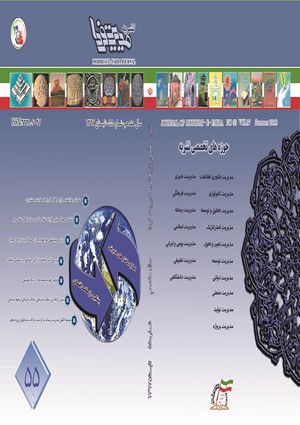ارزیابی عملکرد واحد های IT در صنعت با رویکرد ترکیبی تحلیل سلسله مراتبی فازی (FAHP) و کارت امتیازی متوازن (BSC)
محورهای موضوعی : مدیریت تکنولوژی
1 -
کلید واژه: فرایند تحلیل سلسله مراتب فازی(FAHP) روش امتیازات متوازن(BSC) ارزشیابی عملکرد, تکنولوژی اطلاعات(IT) ,
چکیده مقاله :
در این دنیای در حال تغییر، تکنولوژی اطلاعات(IT) برای بقای شرکت ها، یک ضرورت است، و وظایف واحد IT روز به روز مهمتر می شود. ارزیابی واحد IT برای فهم اینکه چقدر این واحد در اهداف استراتژیک و سازمانی سهیم است، کار حیاتی است. از آنجایی که واحد IT وظایف بسیاری انجام می دهد که به سادگی با واحد های پولی قابل سنجش نمی باشد، روش هایی ارزیابی که به تنهایی بر معیار های مالی تکیه دارد مناسب نیستند. هدف این مطالعه ایجاد یک رویکرد بر اساس فرایند تحلیل سلسله مراتب(FAHP) و روش امتیازات متوازن(BSC) برای ارزشیابی واحد IT در یک شرکت مورد مطالعه می باشد. مفهوم روش امتیازات متوازن برای تعریف سلسله مراتب با چهار چشم انداز عمده یعنی امور مالی، مشتری، فرایندهای کسب و کار داخلی، یادگیری و رشد به کار می رود. برای هر چشم نداز، شاخص های عملکرد انتخاب می شود. سپس یک راه حل برای تحمل ابهام و عدم اطمینان در مورد اطلاعات پیشنهاد می شود. نهایتا یک » فرایند تحلیل سلسله مراتبی فازی « رویکرد سیستم اطلاعاتی " FAHP" برای تسهیل فرایند حل مسئله ایجاد می شود. نتایج، یک راهنمای عمل در مورد استراتژی های بهیود عملکرد واحد، در اختیار واحدهای IT در صنعت مرود مطالعه قرار می دهد.
In this ever-changing world, information technology (IT) is a must for the survival of a company, and the functions of IT department is becoming increasingly important. The assessment of IT department is critical to understand how the department contributes to organizational and strategic goals. Because IT department performs many tasks that cannot simply be measured by monetary units, evaluation methods that solely rely on financial measures are not adequate. The objective of this study is to construct an approach based on the fuzzy analytic hierarchy process (FAHP) and balanced scorecard (BSC) for evaluating an IT department in the company studied. The BSC concept is applied to define the hierarchy with four major perspectives (i.e. financial, customer, internal business process, and learning and growth), and performance indicators are selected for each perspective. A fuzzy AHP (FAHP) approach is then proposed in order to tolerate vagueness and ambiguity of information. A FAHP information system is finally constructed to facilitate the solving process. The results provide guidance to IT departments in the Industry Case Study regarding strategies for improving department performance. The constructed information system is suggested to be a good tool for solving other multiple-criteria decision-making problems.
- حق شناس اصغر، کتابی، دلوی، (1386)، ارزیابی عملکرد با روش امتیازات متوازن از طریق فرایند تحلیل سلسله مراتبی فازی، نشریه مدیریت دانش، سال 20.، شماره 77 ، صص 21-46
- زارعی نژاد محسن، حجتی (1392)، کاربرد مدل تلفیقی-مفهومی IF-AHP و FSIR در کارت امتیازی متوازن به منظور ارزیابی عملکرد واحد های فناوری اطلاعات سیستم های بانکی، نشریه تخصصی مهندسی صنایع، دوره 47 ، شماره 2 ، صص 183-200
- فتحیان محمد، مهریار، غلامیان(1394)، ارائه مدلی برای ارزیابی عملکرد واحد های فناوری اطلاعات و ارتباطات با رویکرد ارتباطات سبز، مدیریت فناوری اطلاعات، دوره 7، شماره 4.
- میرفیض فلاح، راجی ، خواجه پور(1392)، ارزیابی عملکرد سازمان با رویکرد ترکیبی BSC ، AHP و TOPSIS ، مدیریت صنعتی، دوره 5 ، شماره1
5- نیکنام شادی، اصل حداد، طالبی(1387)، ارزیابی عملکرد واحد فناوری اطلاعات و ارتباطات در سازمان ها با استفاده از مدل کارت امتیازی متوازن واحد فناوری اطلاعات و ارتباطات شرکت ملی نفت ایران،کنفرانس بین المللی شهر الکترونیک.
6- A. Abran, L. Buglione, (2003), A multidimensional performance model for consolidating Balanced Scorecards, Advances in Engineering Software 34 (2003) 339–349.
7- A. Manian, M. Fathi, M. Zarchi, A. Omidian, (2011), Performance Evaluating of IT Department using a Modified Fuzzy TOPSIS and BSC methodology (Case study: Tehran Province Gas Company), Journal of management research, Vol. 3, No. 2: E10.
8- Amy H.I. Lee, Wen-Chin Chen, Ching-Jan Chang, (2008), A fuzzy AHP and BSC approach for evaluating performance of IT department in the manufacturing industry in Taiwan, Expert Systems with Applications 34 (2008) 96–107.
9- Ing-Long Wu, Jian-Liang Chen, (2014), A stage-based diffusion of IT innovation and The BSC performance impact: A moderator of technology–organization environment, Technological Forecasting & Social Change 88 (2014) 76–90.
10- J. Swierk, M. mulawa, (2014), It Balanced Scorecard as A Significant Component Of Competitive And Modern Company, management Knowledgr and learning International Conference 2014, 25-27 June 2014.
11- Rodney A. Stewart Sherif Mohamed, (2001),"Utilizing the balanced scorecard for IT/IS performance evaluation in construction", Construction Innovation, Vol. 1 Iss 3 pp. 147– 163. http://dx.doi.org/10.1108/14714170110814578
12- Tzeng, G.H, Chiang, C.H. (2006), Evaluating intertwined effects in e-learning Programs: A novel hybrid MCDM model based on factor analysis and DEMATEL.
13- W. Grembergen, D.timmerman, (1997), monitoring the IT process through the balanced scorecard, working paper, 97-254, November 1997.
14- W. Grembergen, R. Saull, S.Haes, (2000), Linking the IT Balanced Scorecard to the Business Objectives at a Major Canadian Financial group, ITAG research institute.
15- Y.Zeng, l. wing, Y.wang, (2007), A Novel Model for Evaluating Performance of IT Department based on Balanced Scorecard and Artificial Neural Network Approach, computer society, IEEE, Workshop on Intelligent Information Technolog Application.


